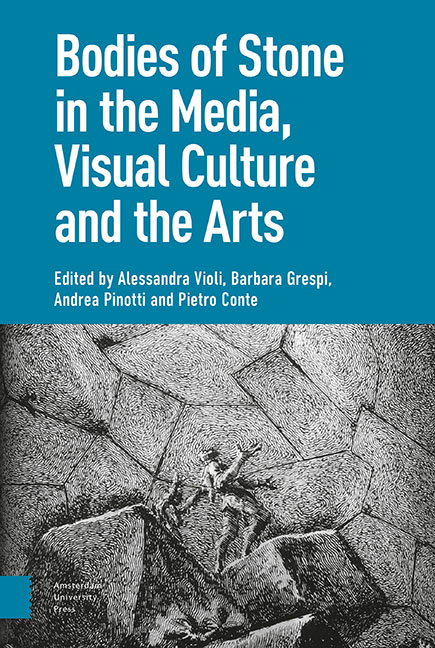Book contents
- Frontmatter
- Contents
- Introduction: Learning from Stone
- I Statue: The Imaginary of Uncertain Petrification
- 1 Theatre and Memory: The Body-as-Statue in Early Modern Culture
- 2 Translated Bodies: A ‘Cartographic’ Approach
- 3 Pantomime in Stone: Performance of the Pose and Animal Camouflage
- 4 Animated Statues and Petrified Bodies: A Journey Inside Fantasy Cinema
- 5 The Ephemeral Cathedral: Bodies of Stone and Configurations of Film
- II Matter: Size, Hardness, Duration
- 1 Bodies That Matter: Miniaturisation and the Origin(s) of ‘Art’
- 2 Brancusi’s ‘Sculpture for the Blind’
- 3 Cinema, Phenomenology and Hyperrealism
- 4 Ephemeral Bodies: The ‘Candles’ of Urs Fischer
- 5 The Celluloid and the Death Mask: Bazin’s and Eisenstein’s Image Anthropology
- III Corpse: Fossils, Auto-Icons, Revenants
- 1 Funeral Eulogy: Post-Mortem Figures and Redeemed Bodies, in Images
- 2 On Jack Torrance As a Fossil Form
- 3 Technical Images and the Transformation of Matter in Eighteenth-Century Tuscany
- 4 Glass, Mixed Media, Stone: The Bodily Stuffs of Suspended Animation
- 5 Bodies’ Strange Stories: Les Revenants and The Leftovers
- IV Monument: Embodying and Grafting
- 1 The Impassibly Fleshly, the Statue of the Impossible
- 2 Frozen into Allegory: Cleopatra’s Cultural Survival
- 3 The Orphan Image
- 4 The Well-Tempered Memorial: Abstraction, Anthropomorphism, Embodiment
- 5 Monuments of the Heart: Living Tombs and Organic Memories in Contemporary Culture
- Index
3 - Technical Images and the Transformation of Matter in Eighteenth-Century Tuscany
Published online by Cambridge University Press: 20 November 2020
- Frontmatter
- Contents
- Introduction: Learning from Stone
- I Statue: The Imaginary of Uncertain Petrification
- 1 Theatre and Memory: The Body-as-Statue in Early Modern Culture
- 2 Translated Bodies: A ‘Cartographic’ Approach
- 3 Pantomime in Stone: Performance of the Pose and Animal Camouflage
- 4 Animated Statues and Petrified Bodies: A Journey Inside Fantasy Cinema
- 5 The Ephemeral Cathedral: Bodies of Stone and Configurations of Film
- II Matter: Size, Hardness, Duration
- 1 Bodies That Matter: Miniaturisation and the Origin(s) of ‘Art’
- 2 Brancusi’s ‘Sculpture for the Blind’
- 3 Cinema, Phenomenology and Hyperrealism
- 4 Ephemeral Bodies: The ‘Candles’ of Urs Fischer
- 5 The Celluloid and the Death Mask: Bazin’s and Eisenstein’s Image Anthropology
- III Corpse: Fossils, Auto-Icons, Revenants
- 1 Funeral Eulogy: Post-Mortem Figures and Redeemed Bodies, in Images
- 2 On Jack Torrance As a Fossil Form
- 3 Technical Images and the Transformation of Matter in Eighteenth-Century Tuscany
- 4 Glass, Mixed Media, Stone: The Bodily Stuffs of Suspended Animation
- 5 Bodies’ Strange Stories: Les Revenants and The Leftovers
- IV Monument: Embodying and Grafting
- 1 The Impassibly Fleshly, the Statue of the Impossible
- 2 Frozen into Allegory: Cleopatra’s Cultural Survival
- 3 The Orphan Image
- 4 The Well-Tempered Memorial: Abstraction, Anthropomorphism, Embodiment
- 5 Monuments of the Heart: Living Tombs and Organic Memories in Contemporary Culture
- Index
Summary
Abstract
The essay investigates the production of scientific images and threedimensional models in the effervescent dialogue between art and science of eighteenth-century Tuscany. Created to meet new didactic needs, these technical images, such as the anatomical tables conceived by anatomist Paolo Mascagni for the students of the Academy of Fine Arts, abandoned the Vesalian topos of the cadaver as a life-like statue and gave rise to a novel lithic iconography, which emphasised the textured materiality of human remains and their potential transformations across the natural and artificial realms. The miscegenation of manufactures and natural productions was given pride of place in anatomical and botanical atlases, as well as in the scientific collections that sprung up in Tuscany at the time.
Keywords: Technical images; anatomy; Paolo Mascagni; lithic iconography; Florentine Academy of Fine Arts Scientific Collections
We must always bear in mind how much the scientist has helped the artist.
‒ A. Targioni Tozzetti, Rapporto delle Adunanze, 1818The question of how to represent the inanimate as living has been and remains crucial to medical anatomical illustration. It is a conceptual issue that has had to be faced up to by authors of various periods and has called forth, from time to time, various visual solutions in such a way as to bring to light and to anticipate, also unconsciously, the moods and themes of modernity.
For this reason, the most recent studies of the iconology of the body in its relations to art and to science have concentrated on the analysis of the technical image, regarded not merely as an illustration or example but recognised in its autonomous role as a primary source in the production of knowledge and as a bearer of decisive contributions to theory construction and to showing such theories’ critical points. Moreover, in the case of the plates in anatomical atlases that were jointly conceived by medics and artists, the technical image turns out to be a device that is particularly apt to the reception of an often implicit set of presuppositions and to convey ancient ideas and superstitions about the body as well as nursing embryonic conceptions and styles of life, thus advancing visions and technical solutions able to represent them.
- Type
- Chapter
- Information
- Bodies of Stone in the Media, Visual Culture and the Arts , pp. 243 - 260Publisher: Amsterdam University PressPrint publication year: 2020

